La Croix de guerre
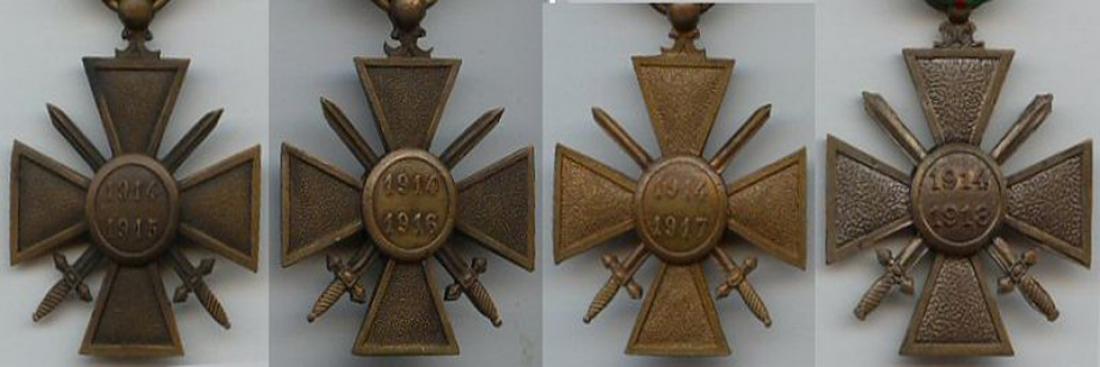
Corps 1
The Croix de Guerre, France's best-known Great War military decoration, was created in 1915 to honour French soldiers, as well as foreign nationals, for distinguished service during the first world conflict. In the 1914 campaign's earliest months France did not have a specific decoration recognising individual acts of bravery. True, the Ordre National de la Légion d'honneur, created in 1802, Médaille Militaire, established in 1852, and regimental citations existed but were seldom awarded in order to keep their prestige high. In November 1914 Maurice Barrès requested "the creation of a new military distinction, a bronze medal so that the commanding officer may decorate his bravest soldiers on the battlefield after each action" (1). In December 1914 a group of parliamentary deputies headed by Bonnefous submitted a bill on the creation of the "medal of military valour" to the Chamber of Deputies' Armed Services Committee. Deputy Driant, the committee's rapporteur, noting that such an honour existed in other countries but not in France, (2), proposed a bill for the adoption of such a decoration, which was to have a short name evoking its recipients' selflessness. It went down in history as the Croix de Guerre, or "War Cross".
Corps 2
This was the time of the Union sacrée, the wartime united front of all political parties, so the bill encountered no obstacles. The only debate focused on the design and the citations' hierarchy. The parliamentarians also discussed the ribbon's colour. Some wanted it to be solid green, like the ribbon of the commemorative medal of the 1870 Franco-Prussian War but without the black stripes that symbolised the loss of Alsace-Lorraine, while others argued for azure blue. They eventually settled on a red-bordered green ribbon with five red stripes: a copy of the ribbon of the Saint Helena medal Napoleon III created in 1857 for the Napoleonic Wars' last veterans. In that way the new medal associated "the glorious memories of past great wars with the great war of today" (3).
On 8 April 1915 a law established the Croix de Guerre to "commemorate individual citations for acts of bravery since the first day of the 1914-1915 war" (4). The medal's design changed as parliamentarians debated and artists made proposals (there were seven). It eventually took the form of a 37mm bronze cross with four flared arms and two crossed swords designed by a sculptor named Bartholomé. The obverse features a medallion in the centre of the cross with a "Marianne" head wearing a Phrygian cap. It is decorated with a laurel wreath and has the words "République Française". The reverse bears the inscription "1914-1915", which was changed every year until the war ended(5). The Croix de Guerre was awarded during official ceremonies with a "present arms" and sometimes entitled recipients to certain benefits, as this account shows: "Yesterday I was awarded the Croix de Guerre with the customary ceremony; but the best part was that the depot commander[...] paid for the champagne and I [...] obtained a leave. I think I'll go tomorrow." (6). Croix de Guerre recipients always wore the medal, even on the battlefield, which was pinned on the left-hand side of the chest just after the Légion d'Honneur and the Médaille Militaire. The application decree of 23 April 1915 spelled out how the citations were to be represented, the conditions in which they were to be obtained and the decoration's general appearance. A specific, distinctive insignia corresponded to each citation-the recognition of an individual act of bravery. It was attached to the ribbon, where there was enough room for several of them. A bronze star symbolised a regiment or brigade citation, a silver star a division citation and silver-gilt star an army corps citation. The bronze palm stood for an army citation. In April 1916 the fourragère, a braided fabric cord with the decoration's colours, was established for group citations. All the soldiers cited wore it when in their unit's presence.
Civilians, foreign nationals, institutions, warships, towns and even animals could receive the Croix de Guerre(7). Nearly 3,000 municipalities in 18 departments were decorated during World War One, starting with Dunkirk in October 1917.
In September 1920 decorated villages-those that had been destroyed during the September 1915 Champagne offensive, such as Tahure, Perthes-les-Hurlus and Massiges-obtained this citation: "Were reduced to the state of glorious rubble during the fierce fighting that immortalised their names, demonstrating, in adversity, the highest qualities of courage and selflessness. Have rightly proven worthy of the nation's gratitude."
On 1 March 1920 the Ministry of War listed 2,055,000 individual citations, but that figure is much lower than the actual one because it does not include posthumous citations and Croix de Guerre accompanied by the Légion d'Honneur and the Médaille Militaire The Croix de Guerre is not a commemorative medal but a highly symbolic decoration honouring individual soldiers' acts of bravery. The fact that it also featured on many everyday items, such as school medals and plates, demonstrates the war's impact on French society. The symbolism of the Croix de Guerre is so powerful that it has given rise to similar insignia with different names, which also reward individual acts during conflicts in which the French army has been involved (Croix des TOE for wars other than the First and Second World Wars not fought on French soil (8), Croix 1939-1945 for the Second World War and Croix de la Valeur militaire for Algeria's War of Independence).
Notes : (1) In Écho de Paris, 27 November 1914. (2) This former officer, famous for the military novels he wrote under the pen name Captain Danrit, met with a tragic end at the head of the 56th and 59th Chasseurs on 21 February 1916. (3) Excerpts from the Murat senate report. (4) Article of the law establishing the Croix de Guerre. (5) A Croix de Guerre from the Great War bears the inscription "1914-1915", "1914-1916", "1914-1917" or "1914-1918". (6) Fernand Demimuid, wartime letters to his parents, 1914-1917, Imprimerie de l'Institution des sourds-muets, 1921, 250 pages, p. 63. (7) The homing pigeon Le Vaillant was the last bird released on 4 June 1916 from besieged Fort de Vaux to accomplish its mission. (8) Theatres of external operations. Association nationale des Croix de guerre et de la valeur militaire Hôtel national des Invalides 129, rue de Grenelle 75007 Paris
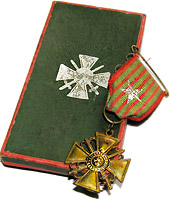
Source : Collection privée
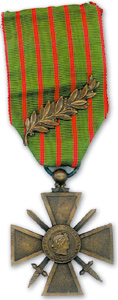
Avers
Source : Collection privée Revers
Source : Collection privée
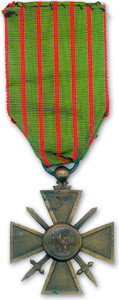
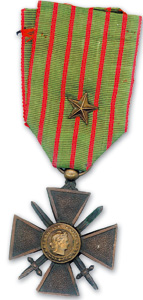
Avers.
Source : Collection privée

